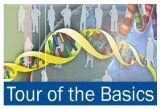 Life Science Space (June 6, 2008)--Scientists at the Babraham Institute, the Sanger Institute, the University of Cambridge and the University of Melbourne and the University of Texas at San Antonio (all part of the SAVOIR consortium) have found that a complex, highly conserved and extremely important mechanism of controlling genes is over 150 million years old. The findings, reported today online in Nature Genetics, have provided new insights into the evolution of genomic or parental imprinting and epigenetic regulation in mammals.
Life Science Space (June 6, 2008)--Scientists at the Babraham Institute, the Sanger Institute, the University of Cambridge and the University of Melbourne and the University of Texas at San Antonio (all part of the SAVOIR consortium) have found that a complex, highly conserved and extremely important mechanism of controlling genes is over 150 million years old. The findings, reported today online in Nature Genetics, have provided new insights into the evolution of genomic or parental imprinting and epigenetic regulation in mammals.We all get two copies of every gene, one from our mother and one from our father. In many cases both copies are used or ‘expressed’, however it is becoming clear that for some genes either the mother’s or the father’s version is used preferentially, a phenomenon known as genomic imprinting. Specific chemical modifications to the DNA, such as methylation, appear to give the chromosomes a ‘memory’ as to their parental origin. These ‘epigenetic’ imprints, from the Greek meaning ‘on top of’, modify the structure of the DNA but not its sequence. In addition to parental modifications, it is thought that epigenetic changes may also arise in response to environmental factors, enabling an organism's genes to adapt and respond differently, even though the gene sequence does not change.

Image Credit: Clinical Tools Inc.
The control of gene expression by imprinting mechanisms has been observed in plants and therians - placental mammals (eutherians) and marsupials (metatherians) - where the majority of imprinted genes are associated with controlling embryonic growth and development, including the development of the placenta. Other imprinted genes are involved in post-natal development, processes like suckling and metabolism.
Imprinting is thought to have evolved because of genetic conflict that influences the allocation of resources from parents to offspring. The origin of this seems to stem from there being different developmental priorities for each parent - the father desires one large, strong offspring from each possible mother whereas the mother prefers to distribute resources equally among all her young (or potential young).
The insulin-like growth factor signalling pathway, which has a major influence on fetal size, is exemplary of this parental-offspring conflict. It contains two components encoded by the oppositely imprinted genes, Igf2 (a growth promoting factor expressed from the father's version of the gene) and Igf2r (a growth inhibitory factor expressed from the maternal copy). In eutherians, these two genes lie on separate chromosomes and are imprinted by different epigenetic mechanisms. In marsupials, IGF2 and IGF2R are known to be imprinted but the IGF2R imprinting mechanism is different than in eutherians (much simpler) and the IGF2 imprinting mechanism is unknown.

Image credit: Nature Genetics
To unravel the origins of genomic imprinting and mechanisms underpinning parental specific gene expression, the SAVOIR consortium has planned to obtain and analyse the sequence of all major clusters of imprinted genes from mammals where imprinting has been observed including human, mouse and wallaby, with those apparently lacking imprinting mechanisms, such as platypus and chicken.
Mammals are divided into three groups; Monotremata, Marsupialia and Eutheria, the latter two forming the therian class. Recent evidence suggests that therians diverged from the egg-laying monotremes like the platypus approximately 180 million years ago, and then split into the eutherian and marsupials infra-classes around 150 million years ago.
The apparent absence of genomic imprinting in monotremes and presence in eutherians and marsupials suggests that imprinting has evolved at the boundary of monotremes and therians’ divergence. Interestingly, imprinting evolution paralleled the apparition of the placenta and implantation. Indeed, eutherian have a developed placenta that transfers a lot of nutrients to the fetus over a long gestation period while marsupials have a rudimentary placenta and give birth to very immature youngs that spend a long time in a pouch where they suckle milk. Both eutherian and marsupials having a placenta implies that the therian ancestor was a placental mammal. In contrast the monotremes’ gestation shows only gas exchange through the shell before the egg being laid. Hence, it is possible that imprinting and placentation co-evolved in the therian ancestor.
The next stage is to look for the IGF2-H19 locus in another branch of mammals’ evolution – the monotremes (egg laying mammals which lactate) – where so far genomic imprinting has not been seen. The recent platypus genome project didn’t succeed in obtaining the sequence of the monotreme IGF2-H19 locus demonstrating the importance of both large scale and more focused genomics projects like ours. Hence the SAVOIR consortium will concentrate its efforts in obtaining the sequence of the monotreme IGF2 locus to provide further insights into the imprinting evolution and the mysteries of gene regulation in these curious creatures which carry mammalian, bird-like and reptilian characteristics.
Finally, the conservation for 150 million years of the H19 non-coding RNA and of different features it harbours (as for example a microRNA hairpin) raises important questions about the function of this gene. MicroRNAs, also known as short interfering RNAs, are short (22-25 base) sequences that are copied from DNA (but do not code for protein) and control gene activity by binding to specific related sequences. This interferes with a gene’s ability to produce the proteins (translation) that co-ordinate cellular activities or can lead to destruction of other RNA molecules. Previous work has indicated that H19 may have a role either in tumour suppression or in oncogenesis, and our findings should give fresh impetus to discover what this intriguing RNA really regulates in normal development and in disease, and why it is so highly conserved
---------------------------------------------------------------------Source: http://www.babraham.ac.uk/news2008/jun-29.html
Learn more about genomic imprinting @: http://www.nature.com/nrg/journal/v4/n5/box/nrg1062_BX3.htmlttp://www.babraham.ac.uk/news2008/jun-29.html
.jpg)
.jpg)
.jpg)

.jpg)
.jpg)
No comments:
Post a Comment